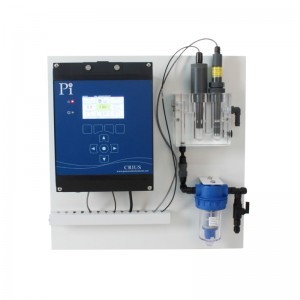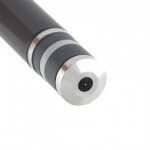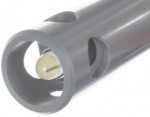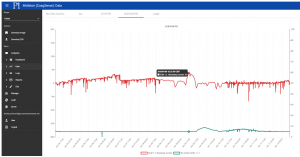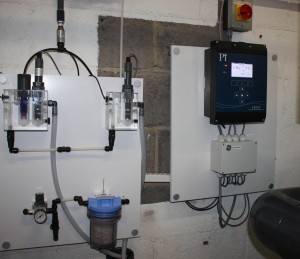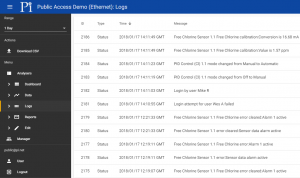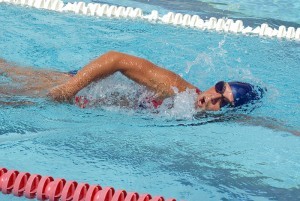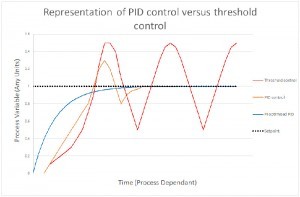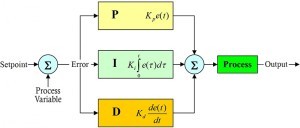Swimming pools and spas use chlorine as a disinfectant and so use an analyzer to control the amount of chlorine that gets dosed. The AquaSense Swimming Pool Controller and Spa Controller measures the pool chlorine levels and the pH of the pool and then controls the chlorine and pH levels by controlling the chemical dosing. The AquaSense offers bufferless and reagentless operation and is suitable for commercial, municipal and community swimming pools.
The AquaSense has been designed to three criteria:
- Improved Safety – better sensors lead to better process control which leads to less variation in chlorine residuals even with highly variable bathing load.
- Improved Control – better process control leads to reduced chemical usage, lower costs and an improved bathing experience.
- Reduced Costs – lower chemical costs, less expensive controllers, inverter control leading to hugely reduced electrical usage costs are just a few of the ways that the AquaSense can save you money which can pay for a new controller in just a few months.
Traditionally pool chemistry has been controlled by using ORP (Redox) or residual chlorine sensors. The quality of the sensors has a huge effect on the ability of the controller to maintain a safe and pleasant bathing water. The sensors used in AquaSense controllers are the best available in the world today and are exactly the same sensors that are used to monitor and control drinking water in many municipal drinking water plants worldwide.
Chlorine Sensors
Three sensors are available to measure free chlorine, total chlorine, or chlorine in the presence of cyanuric acid. All of these sensors have a long life (10 years) with reduced maintenance and calibration requirements. They are very high quality and very easy to maintain. Being able to accurately measure the chlorine and respond to varying bathing loads means that pools and spas can operate at lower chlorine levels, reducing the formation of unpleasant combined chlorines and reducing the chemical usage, thereby reducing costs, reducing emissions, all while providing a better bathing experience.
pH and ORP Sensors
The pH and ORP sensors are made specifically for the AquaSense controllers and come with either a one or two year warranty. These AquaSense pH and ORP sensors are based on those used in the water industry and are not the low cost, low quality sensors that are often supplied into the pool industry.
Some of the key benefits of Pi’s CRONOS® AquaSense and CRIUS® AquaSense are:
- Inverter control for massive electricity and CO2 savings
- Stable and reliable residual chlorine and pH measurement and control
- Low purchase cost
- Low cost of ownership
- SMS text alarms
- Remote access via Internet
- Suitable for fresh water, salt water and outdoor pools with cyanuric acid
- Private label option for re-sellers
- Other inputs to data log and alarms
The sensors used in AquaSense are the same sensors that we use in our water treatment analyzers, meaning that you get the highest quality sensors at the best price.
Pi usually supplies the AquaSense via pool builders or pool maintenance contractors where we add value by offering a private label option and a bespoke remote access option whereby the pool expert can be in the pool room, in control, wherever they are in the world.
Additionally onboard variable speed drive controls typically save some operators the installation and purchase costs within a year giving a better than 12 month pay back.
The AquaSense swimming pool controller is on site in many pools and spas around the world. It is the residual chlorine swimming pool controller of choice for many because of its superior chlorine measurement. Spas offer a more difficult chlorine control problem because of the higher temperatures and the low volume of water. The AquaSense pool and spa controller offers far superior control in spas.
With the latest pool and spa controllers from Pi you can often achieve a 3 month pay back, both reducing your costs and improving the bathing experience of your pool users.
For many years cheap sensors and controllers have prevailed in the pool industry leading to poor quality bathing water and a poor quality bathing experience.
Often operators don’t know how poor their controllers are, thinking that the poor performance is normal. Pi use the same sensors for controlling chlorine in swimming pools as we use for controlling chlorine in drinking water. Based on their superior sensors and controllers, Pi can:
- Save money by controlling pool recirculating pumps
- Eliminate bacteriological growths in pools and spas
- Optimize the chemical usage
- Eliminate ‘red eye’ and chlorine smells
The AquaSense is a sophisticated device capable of controlling many aspects of the pool including the chlorine levels, the pH and if a variable speed device is fitted, the speed of the recirculating pumps.
Most pool recirculating pumps are over specified for the duty required and as such there is scope to turn them down and save considerable amounts of money on the electricity usage. Whenever you save electricity you are reducing the CO2 emissions and the carbon footprint of your pool and spa, and for many organizations reducing CO2 emissions is a significant factor in choosing which equipment to purchase.
In order to turn down the pool recirculating pump the pump motor must be fitted with an inverter. The question then arises – on what basis do we turn the motor down? Each pool has a minimum turnover set by the manufacturer or consultant at the time of installation. The CRIUS® AquaSense allows the user to turn down the recirculating pump during periods of non pool use (overnight) to the minimum level. Whilst the pool is being used the recirculating pump motor speed is set based on chlorine demand (which is proportional to bathing load). This ability to control the recirculating pump based on chlorine demand means that pool operators can save significant sums of money on electricity during the day when electricity costs the most. This can lead to a three month pay back on some pools. Please contact your local sales team for references.
In the modern commercial swimming pool or spa, a swimming pool controller or a spa controller must offer advanced communication and control options, including inverter control. In many pools and spas, the disinfection control and the systems are maintained by service professionals that are based off site and the ability of these engineers to respond quickly and effectively to a process upset at a pool depends on them getting the correct information as soon as possible.
The AquaSense swimming pool and spa controller provides remote access via mobile phone, texts and via the internet using a 2G or 3G mobile phone modem, thereby saving time and money in not having to attend site unless strictly necessary. Click here for an online demonstration.
The highly sophisticated proactive text alarms and remote access capability of the CRIUS® AquaSense, means that:-
- Improved Communication – the right people know as soon as something happens.
- Improved Control– your expert is in your pool room no matter where they are.
- Less Time to Fix Problems – the time taken to fix any problems is greatly reduced.
- Reduced Costs – time, cost and CO2 emissions are reduced, due to less time travelling and less miles travelled.
Many leisure facilities are now fitted with sophisticated BMS (Building Management Systems) and Pi’s pool and spa controllers are able to communicate directly to the BMS whatever system it might be. Every AquaSense from Pi can come equipped with inverter control and a range of communication protocols including LAN, Profibus, Modbus and more traditional analogue and digital outputs.
Save Money and the planet! Most pool recirculating pumps are over specified for the duty required and as such there is scope to turn them down and save considerable amounts of money on the electricity usage. Whenever you save electricity you are reducing the CO2 emissions and carbon footprint of your pool and spa and for many organizations reducing CO2 emissions is a significant factor in choosing which equipment to purchase. It might not really save the planet but it is a good start! In order to turn down the pool recirculating pump the pump motor must be fitted with an inverter. The question then arises – on what basis do we turn the motor down?
Each pool has a minimum turnover set by the manufacturer or consultant at the time of installation. The CRIUS® AquaSense allows the user to turn down the recirculating pump during periods of non pool use (overnight) to the minimum level using the built-in inverter control algorithms. While the pool is being used the recirculating pump motor is set based on chlorine demand which is proportional to bathing load. This ability to control the inverter and therefore the recirculating pump based on chlorine demand means that pool operators can save significant sums of money on electricity during the times when electricity costs the most. Saving on chemical use can also be significant. The AquaSense inverter control is the most complete, sophisticated and effective currently available anywhere in the world.
The AquaSense can also be fitted with other sensors depending on the needs of your pool or spa. These may include for example
- Particle Counters (filter optimization)
- Turbidity (clarity optimization)
- Streaming Current (coagulant optimization)
- UV254 Transmission (UV disinfection optimization)
- Ozone (disinfection control)
- Chlorine Dioxide (disinfection control)
- TDS (Total Dissolved Solids)
| Document | Type | Size |
|---|---|---|
AquaSense |
Brochure | 1.3mB |
AquaSense |
Article | 639kB |
AquaSense Operator Notes |
Technical Note | 413kB |
CRONOS® |
Brochure | 582kB |
CRIUS® |
Brochure | 584kB |
CRIUS® Remote Communications |
Brochure | 573kB |
| CRONOS® and CRIUS® Control Options | Technical Note | 520kB |
Remote Access GPRS |
Technical Note | 554kB |
PID Control |
Technical Note | 541kB |
Autoflush |
Brochure | 434kB |
Focus Ons are a series of short articles distributed by email providing technical information regarding instrumentation, process measurement in potable, waste, process and pool waters. If you would like to join the mailing list, please contact us.
Did you know…
… that PID can save you money by offering better process control?
… that PID can help you maintain a setpoint, even with a variable process?
… that the days of over complex and confusing PID are over?
… that Pi can tailor a PID system to your exact requirements? You may never have to touch those settings again!
In this Focus On, Pi would like to introduce you to PID if you haven’t come across it, and discuss some of the useful advanced features of modern PID systems, like on Pi’s CRONOS® and CRIUS® models for those more familiar with PID.
What is PID?
PID is a mathematical tool created by engineers and is used in controllers. It is a feature often found in industrial controllers and is available in Pi’s controllers, as an inexpensive upgrade.
What is PID for?
The best way to explain what PID does, is to take an example. Most people have been to a swimming pool at some point in their lives, so this is the example we shall use. PID is also applicable in a huge variety of other processes. If you are not sure, you can always contact us to discuss your application.
When a person enters a swimming pool, they create a chlorine demand. They do this by introducing sweat, bacteria, organic molecules and other substances into the pool water. Chlorine reacts with these substances, which results in chlorine being used up and the chlorine level dropping. The chlorine level in this example, is often called the process variable or PV in the context of PID.
In order to maintain a concentration or level of chlorine, more chlorine needs to be dosed. If you dosed the same amount of chlorine per bather, the level would not be stable as all bathers create a different chlorine demand (e.g. swimming for fitness produces more sweat than swimming recreationally). Dosing manually brings in the issue of human error, and how operators approximate or calculate the amount of chlorine to dose based on current levels. Another issue with manual dosing is that it is not a continuous process, meaning it is unlikely a stable level will ever be reached.
What does PID do?
PID takes the measured level of chlorine or the PV and compares it to the desired level or set-point. This comparison gives the error which PID interprets and then calculates an output. The output is an electrical signal which controls the dosing of the appropriate chemical. The output can control heaters, dosing pumps and many other mechanisms that can be used to change the PV.
How is PID used?
PID is made up of three parts, proportional, integral and derivative. Understanding what each part does helps operators choose the level of control best suited to them.
Proportional
Is the most commonly used for portion PID and suits most applications. When using proportional control, the further away the measured value is from the setpoint, the larger the output will be from the controller. This is an appropriate level of control for most processes, and users can gain a lot of control from a purely proportional system.
In some systems where the PV is lost to the process, e.g. chlorine from a pool, heat from a boiler etc., the proportional control never quite catches up with the setpoint. Users can see that although the process approaches the setpoint it rarely, if ever, gets to it. This is known as ‘droop’. The user can compensate for droop if the removal of the PV is fairly constant, simply by raising the setpoint, e.g. evaporation of chlorine from an empty pool. If droop changes often, (e.g. bather load or chlorine demand) then to eradicate the ‘droop’ then the integral part of PID can be applied to the signal to correct it.
Integral
The output from the integral term is determined by both the magnitude and the duration of the error. A small error over a long period of time will trigger a larger response than from a purely proportional system. This helps the elimination of the ‘droop’ seen in processes with continuous loss, and also serves to help reach the setpoint quicker.
Derivative
Derivative gain is rarely used and is generally set up only by expert engineers. Derivative gain uses the rate of change in the PV to try and predict future errors. This type of control is particularly susceptible to overcompensating, especially if there is even a small amount of signal noise (usually seen as spikes in the PV). Derivative gain is generally a tweak used by engineers to improve an already tight control, and is almost never used as an essential part of control.
What are the benefits of PID?
When properly set up, PID can lead to far tighter process control, which in turn can save you time and money. As an example, pool managers want to keep chlorine levels low, to improve the bathing experience and also save on chemicals. AquaSense is a chlorine analyzer system that responds quickly and appropriately to a change in bather load (also known as chlorine demand). This means pool operators can save money whilst maintaining the safety of the pool. PID can also help reduce the risk of overshooting the desired setpoint, reducing the risk of dangerous overdosing of the chemicals.
Advanced Features and Safeguards
Whilst maintaining a setpoint with a PID loop is a huge advance over using threshold relays to maintain an upper and lower limit, it is sensible to control the loop with extra safeguards, such as:
- Maximum and minimum pump outputs. This is mainly used to prevent the controller from employing too aggressive a control, which can lead to overdosing. A minimum output can also be used in a system where the measured parameter is lost over time, to prevent the controller ever turning the dosing off.
- Ramp rate is a proportional control that allows users to choose how quickly or slowly the controller doses, in order to reach the setpoint. It is especially useful on startup, and can prevent the controller dosing too quickly.
- Wind up protection is an integral control, which limits the duration aspect of the control. This puts a limit on how much previous error can accumulate. Without wind up protection, there could be a very large integral value, if the process ever reaches zero or on startup.
These are all standard features in all Pi PID controllers.
Conclusion
In summary, PID is a very useful tool when used correctly, and can result in significant chemical savings, not to mention reduced pump wear and tear and lower electricity costs.
A VSD is an electronic device which enables the pump motor to be turned up or down thus increasing or lowering the pump speed.
Most pool recirculating pumps are over specified for the duty required and as such, there is scope using VSDs to turn them down when possible and save considerable amounts of money on electricity costs.
Did you know that…
… VSD control has saved some swimming pools more than 35% on their electricity bills?
… Pi’s VSD control saves money during the night and even during the day when electricity tariffs are highest?
… VSD control is available on both Pi’s CRONOS® and CRIUS® controllers?
The Problem : HIgh Electricity Bills & High CO2 Footprint.
High electricity bills and high CO2 footprint.
Most swimming pools and spas spend considerable amounts of money on electricity to run their pool water recirculation pumps. These pumps are often over specified, running at full power even when there are few or no bathers using the pool or spa during the daytime. With recirculation pumps continually running at full power, the monthly electricity bills can be very high. A result of this high electricity demand is an increased carbon footprint of the pool or spa. Current VSD controls only lower the pump speeds to reduce the pool or spa’s water recirculation to a minimum overnight when there are no bathers.
The Solution: Pi’s CRONOS® & CRIUS® Controllers with VSD
Process Instruments’ CRONOS® and CRIUS® Controllers with VSD
What is required is a VSD control which in addition to reducing power consumption overnight can also save costs during the day by turning the pumps down when there are few bathers.
Pi’s controllers have the capability to utilize the VSD control during the day and at night; swimming pools and spas can benefit from turning the pumps down even during the day when electricity costs are highest.
How does VSD control work?
Pi’s VSD control sets the recirculation pump motor automatically, while the pool is being used, based on biocide demand. Biocide demand is directly linked to the number of people using the pool or spa, therefore Pi’s controllers can reduce pump speeds and electricity costs during periods of fewer bathers.
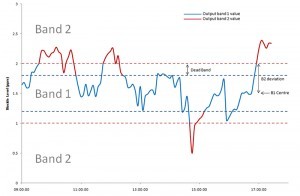 The graph shows how VSD control works, based on biocide demand. Looking at the graph, thresholds are set at different levels of biocide. These thresholds are then used to create biocide level bands, with each band being attributed with a specific pump speed. This optimizes water recirculation whilst maintaining the minimum turnover set by the manufacturer or consultant at the time of installation. During daytime periods when the number of pool users fluctuates, the bather load increases/decreases respectively. As the biocide demand is directly proportional to the bather load, fewer users will result in biocide levels dropping below the band threshold thus enabling a reduced pump speed during the day. Pi’s VSD control exploits this relationship between biocide demand and bather load adjusting the pumps speeds during the day hence saving the pool or spa money on electricity.
The graph shows how VSD control works, based on biocide demand. Looking at the graph, thresholds are set at different levels of biocide. These thresholds are then used to create biocide level bands, with each band being attributed with a specific pump speed. This optimizes water recirculation whilst maintaining the minimum turnover set by the manufacturer or consultant at the time of installation. During daytime periods when the number of pool users fluctuates, the bather load increases/decreases respectively. As the biocide demand is directly proportional to the bather load, fewer users will result in biocide levels dropping below the band threshold thus enabling a reduced pump speed during the day. Pi’s VSD control exploits this relationship between biocide demand and bather load adjusting the pumps speeds during the day hence saving the pool or spa money on electricity.
In addition to pools and spas saving money on their electricity, they are effectively reducing CO2 emissions and the carbon footprint of their establishment. For many organizations, reducing CO2 emissions is a significant factor in choosing which equipment to purchase.
Swimming Pool Application Savings Data
For a commercial swimming pool (210m3) the monthly savings on electricity using VSD control were calculated.
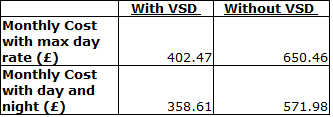 The power consumption of the recirculation pump was recorded for a month with Pi’s VSD control enabled and without VSD for the same period. Using standard day and night electricity tariffs, it was possible to calculate how much money can be saved by this feature.
The power consumption of the recirculation pump was recorded for a month with Pi’s VSD control enabled and without VSD for the same period. Using standard day and night electricity tariffs, it was possible to calculate how much money can be saved by this feature.
 Over a period of a month, energy costs were calculated.
Over a period of a month, energy costs were calculated.
From these results it can be seen that Pi’s VSD control saved £213 a month at this single commercial swimming pool. This is a significant reduction not only in cost but also the CO2 footprint of the site. The larger the pool and spa, the bigger the pump that is required to recirculate, therefore the more money that can be saved on electricity. Using the VSD control; Pi’s controllers could pay for themselves in 6 months or less.





















